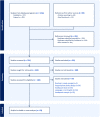Prevalence of attention-deficit hyperactivity disorder in children, adolescents and adults in the Middle East and North Africa region: a systematic review and meta-analysis
- PMID: 38238059
- PMCID: PMC10806616
- DOI: 10.1136/bmjopen-2023-078849
Prevalence of attention-deficit hyperactivity disorder in children, adolescents and adults in the Middle East and North Africa region: a systematic review and meta-analysis
Abstract
Objectives: To systematically estimate the overall prevalence of attention-deficit hyperactivity disorder (ADHD) in children, adolescents and adults across the Middle East and North Africa (MENA) region.
Design: Systematic review and meta-analysis conducted according to the Preferred Reporting Items for Systematic Reviews and Meta-analyses (PRISMA) statement.
Data sources: Medline and Scopus databases were comprehensively and systematically searched between 1990 and February 2023.
Eligibility criteria for selecting studies: We included all cross-sectional or cohort studies that diagnosed ADHD using validated diagnostic tools (eg, Diagnostic and Statistical Manual of Mental Disorders, Fifth Edition criteria, ADHD rating scales and ADHD diagnostic interview) or non-validated tools (eg, brain imaging techniques, computerised cognitive tests and quantitative electroencephalography).
Data extraction and synthesis: Two reviewers performed the data extraction independently using standardised data collection sheet. Newcastle-Ottawa Scale was used to assess the quality of the included studies. Individualised and pooled event rate and upper and lower limit at 95% CI were calculated according to the ADHD cases and the total sample size using a random-effect model. The subgroup prevalence analyses according to ADHD subtypes, gender, MENA country and age were also performed.
Results: A total of 63 articles met the inclusion criteria involving 849 902 participants. The overall prevalence of ADHD was 10.3% (95% CI 0.081 to 0.129). The prevalence rate ranged from 1.3% (Yemen) to 22.2% (Iran). Subgroup analyses showed that the prevalence in adults was 13.5 and 10.1 in children and adolescents. Males exhibited significantly higher prevalence compared with females as these were 11.1% and 7%, respectively. Attention-deficit subtype was significantly the most prevalent (46.7%) compared with hyperactivity/impulsivity (33.7%) and combined types (20.6%).
Conclusion: The overall prevalence of ADHD was high in the MENA region. It is crucial to allocate more attention and resources towards the prevention and treatment of ADHD in children, adolescents and adults within the region.
Keywords: adolescent; adult neurology; adult psychiatry; mental health; public health.
© Author(s) (or their employer(s)) 2024. Re-use permitted under CC BY-NC. No commercial re-use. See rights and permissions. Published by BMJ.
Conflict of interest statement
Competing interests: None declared.
Figures
Similar articles
-
Epidemiology of attention-deficit/hyperactivity disorder (ADHD) in children and adolescents in Africa: a systematic review and meta-analysis.Ann Gen Psychiatry. 2020 Mar 13;19:21. doi: 10.1186/s12991-020-00271-w. eCollection 2020. Ann Gen Psychiatry. 2020. PMID: 32190100 Free PMC article. Review.
-
Treatment Rates for Mental Disorders Among Children and Adolescents: A Systematic Review and Meta-Analysis.JAMA Netw Open. 2023 Oct 2;6(10):e2338174. doi: 10.1001/jamanetworkopen.2023.38174. JAMA Netw Open. 2023. PMID: 37851443 Free PMC article.
-
Association of Attention-Deficit/Hyperactivity Disorder in Childhood and Adolescence With the Risk of Subsequent Psychotic Disorder: A Systematic Review and Meta-analysis.JAMA Psychiatry. 2021 May 1;78(5):519-529. doi: 10.1001/jamapsychiatry.2020.4799. JAMA Psychiatry. 2021. PMID: 33625499 Free PMC article.
-
Prevalence and comorbidity of attention deficit hyperactivity disorder in Spain: study protocol for extending a systematic review with updated meta-analysis of observational studies.Syst Rev. 2019 Feb 11;8(1):49. doi: 10.1186/s13643-019-0967-y. Syst Rev. 2019. PMID: 30744675 Free PMC article.
-
Prevalence of bone fractures among children and adolescents with attention-deficit/hyperactivity disorder: a systematic review and meta-analysis.BMC Pediatr. 2021 Aug 19;21(1):354. doi: 10.1186/s12887-021-02821-x. BMC Pediatr. 2021. PMID: 34412606 Free PMC article.
Cited by
-
Exploring the Links between Physical Activity, Emotional Regulation, and Mental Well-Being in Jordanian University Students.J Clin Med. 2024 Mar 7;13(6):1533. doi: 10.3390/jcm13061533. J Clin Med. 2024. PMID: 38541759 Free PMC article.
-
Standardization of the Arabic Version of the Adult ADHD Self-Report Screening Scale for DSM-5 (ASRS-5) Among Adults in Saudi Arabia: Variability of ADHD Screening According to Sociodemographic Variables.J Atten Disord. 2025 Apr;29(6):445-457. doi: 10.1177/10870547251313879. Epub 2025 Jan 24. J Atten Disord. 2025. PMID: 39851051 Free PMC article.
-
Assessment of the Quality of Life and Family Function in Attention Deficit Hyperactivity Disorder Caregivers in Al-Ahsa, Saudi Arabia.Cureus. 2024 Sep 25;16(9):e70161. doi: 10.7759/cureus.70161. eCollection 2024 Sep. Cureus. 2024. PMID: 39463622 Free PMC article.
-
New frontiers in pharmacological treatment of attention-deficit hyperactivity disorder.Naunyn Schmiedebergs Arch Pharmacol. 2025 Jun 6. doi: 10.1007/s00210-025-04328-z. Online ahead of print. Naunyn Schmiedebergs Arch Pharmacol. 2025. PMID: 40478337 Review.
-
Neuropsychological and Academic Performance in Colombian Children with Attention-Deficit Hyperactivity Disorder: A Comparative Study with a Control Group.Children (Basel). 2025 Apr 26;12(5):561. doi: 10.3390/children12050561. Children (Basel). 2025. PMID: 40426740 Free PMC article.
References
Publication types
MeSH terms
LinkOut - more resources
Full Text Sources
Medical
Research Materials
Miscellaneous

